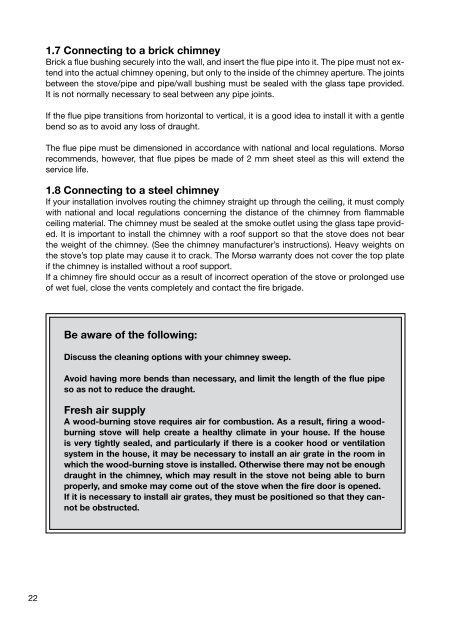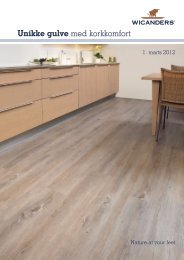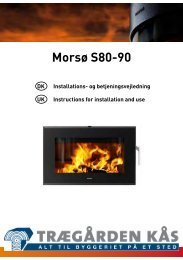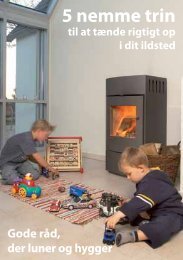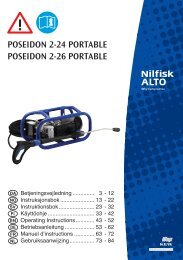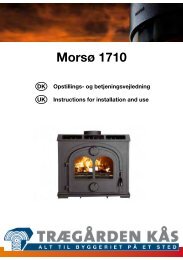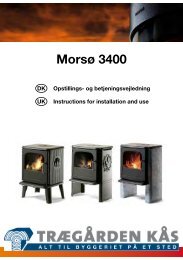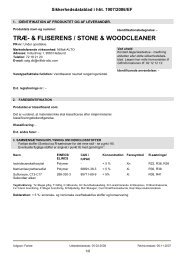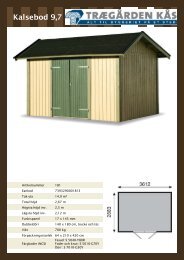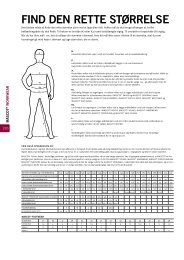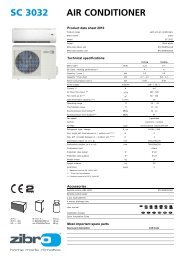Morsø 1126
Morsø 1126
Morsø 1126
You also want an ePaper? Increase the reach of your titles
YUMPU automatically turns print PDFs into web optimized ePapers that Google loves.
1.7 Connecting to a brick chimney<br />
Brick a flue bushing securely into the wall, and insert the flue pipe into it. The pipe must not extend<br />
into the actual chimney opening, but only to the inside of the chimney aperture. The joints<br />
between the stove/pipe and pipe/wall bushing must be sealed with the glass tape provided.<br />
It is not normally necessary to seal between any pipe joints.<br />
If the flue pipe transitions from horizontal to vertical, it is a good idea to install it with a gentle<br />
bend so as to avoid any loss of draught.<br />
The flue pipe must be dimensioned in accordance with national and local regulations. <strong>Morsø</strong><br />
recommends, however, that flue pipes be made of 2 mm sheet steel as this will extend the<br />
service life.<br />
1.8 Connecting to a steel chimney<br />
If your installation involves routing the chimney straight up through the ceiling, it must comply<br />
with national and local regulations concerning the distance of the chimney from flammable<br />
ceiling material. The chimney must be sealed at the smoke outlet using the glass tape provided.<br />
It is important to install the chimney with a roof support so that the stove does not bear<br />
the weight of the chimney. (See the chimney manufacturer’s instructions). Heavy weights on<br />
the stove’s top plate may cause it to crack. The <strong>Morsø</strong> warranty does not cover the top plate<br />
if the chimney is installed without a roof support.<br />
If a chimney fire should occur as a result of incorrect operation of the stove or prolonged use<br />
of wet fuel, close the vents completely and contact the fire brigade.<br />
Be aware of the following:<br />
Discuss the cleaning options with your chimney sweep.<br />
Avoid having more bends than necessary, and limit the length of the flue pipe<br />
so as not to reduce the draught.<br />
Fresh air supply<br />
A wood-burning stove requires air for combustion. As a result, firing a woodburning<br />
stove will help create a healthy climate in your house. If the house<br />
is very tightly sealed, and particularly if there is a cooker hood or ventilation<br />
system in the house, it may be necessary to install an air grate in the room in<br />
which the wood-burning stove is installed. Otherwise there may not be enough<br />
draught in the chimney, which may result in the stove not being able to burn<br />
properly, and smoke may come out of the stove when the fire door is opened.<br />
If it is necessary to install air grates, they must be positioned so that they cannot<br />
be obstructed.<br />
22


